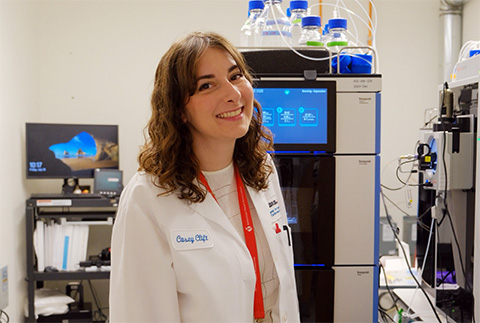Understanding the roles of extracellular matrix and vesicles in valvular disease
Dr. Cassandra Clift’s career exemplifies the strength of interdisciplinary science. With roots in biomedical engineering and a growing research portfolio in cardiovascular biology, she draws on a wide range of expertise — from bioinstrumentation, such as mass spectrometry, to biomaterials — to investigate how different populations of extracellular vesicles contribute to heart disease. Now a postdoctoral fellow at Harvard Medical School and a former American Maximizing Opportunities for Scientific and Academic Independent Careers scholar, Clift is building a research path that bridges engineering and biology, and will soon establish her own research program as an assistant professor at the Medical University of South Carolina.

Clift grew up on the outskirts of Connecticut in the small town of Windsor Locks. A first-generation college graduate, she remained in New England to study biomedical engineering with a focus on biomaterials at Worcester Polytechnic Institute. While extending her undergraduate program to complete a capstone project in bioinstrumentation, she also worked full-time in industry as a polymer research and development technician at Gentex Optics in Massachusetts.
Curious about how academic science worked, Clift took a research technician position at the Medical University of South Carolina. There, in Dr. Martin Morad’s lab, she was brought in for her instrumentation expertise to repair amplification and microscopy equipment used in electrophysiology research, but in the process, stem cell genetic engineering and calcium signaling by developing genetically encoded calcium sensors to better understand arrythmias. In this role, Clift found herself drawn to the freedom and fun of academic research. “I just fell in love with academic research and knew I wanted to pursue a Ph.D.,” she said.
With a background in bioengineering, Clift faced a challenge when applying to more basic science and translational-based biomedical sciences Ph.D. programs. “A lot of people I was interviewing with saw my bioengineering background as a hindrance,” she said. “They thought I didn’t have enough of a biology background to succeed in the biomedical field.”
Eventually, she found the right fit in Dr. Peggi Angel’s lab, where she was encouraged to see her engineering experience as an asset. “She was and is an exceptional mentor who really appreciates everyone’s unique background and helps her mentees work towards their specific goals,” Clift recalled. Under Angel’s mentorship, Clift began to integrate biology into her work more deeply, bringing her Ph.D. focus into a balanced mix of biology and bioinstrumentation.
In Dr. Angel’s lab, Clift developed new methods to target and image the extracellular matrix and glycospecies using imaging mass spectrometry. She also explored how collagen is dysregulated in bicuspid aortic valve disease — a congenital heart defect affecting about 1.3% of adults. Her thesis work connected the dots between translational cardiovascular biology and mass spectrometry methodologies.
After completing her Ph.D., Clift joined Dr. Elena Aikawa’s lab at Harvard Medical School and Brigham and Women’s Hospital, where she is using multiomics and epigenetic tools to study cardiovascular calcification in both human tissues and bioengineered models. One aspect of this work is to study the structure and function of extracellular vesicles in heart disease. “Dr. Aikawa is a pioneer and major figure in the cardiac valve community. She helped me expand my network and taught me a lot about succeeding in academia and translational science.” In her future independence, Clift will focus on glycan-mediated signaling in extracellular vesicles in valvular and vascular fibrosis and calcification.
“Valves and vessels are great organs to study for bioengineers,” Clift said. “They’re some of the most biomechanically stressed tissues in the body; unfortunately, the only solution to cure valve disease is surgical repair or replacement, so both biomarkers and therapeutic targets are desperately needed.” She looks forward to collaborating with interdisciplinary teams of bioengineers and clinicians to develop better tools and therapies. For Clift, interdisciplinary science isn’t just an approach — it’s a necessity. “I want to be the bridge among specialists from different fields. My happy place is developing mass spectrometry-based approaches to help my collaborators and propel the field forward.”
Enjoy reading ASBMB Today?
Become a member to receive the print edition four times a year and the digital edition monthly.
Learn moreGet the latest from ASBMB Today
Enter your email address, and we’ll send you a weekly email with recent articles, interviews and more.
Latest in People
People highlights or most popular articles

Building the blueprint to block HIV
Wesley Sundquist will present his work on the HIV capsid and revolutionary drug, Lenacapavir, at the ASBMB Annual Meeting, March 7–10, in Maryland.

In memoriam: Alan G. Goodridge
He made pioneering discoveries on lipid metabolism and was an ASBMB member since 1971.

Alrubaye wins research and teaching awards
He was honored at the NACTA 2025 conference for the Educator Award and at the U of A State and National Awards reception for the Faculty Gold Medal.

Designing life’s building blocks with AI
Tanja Kortemme, a professor at the University of California, San Francisco, will discuss her research using computational biology to engineer proteins at the 2026 ASBMB Annual Meeting.

Jordahl named Gilliam Fellow
He will receive three years of funding to support his thesis research.

Bibel named assistant professor
She began her position at Loyola Marymount University in August 2025.

